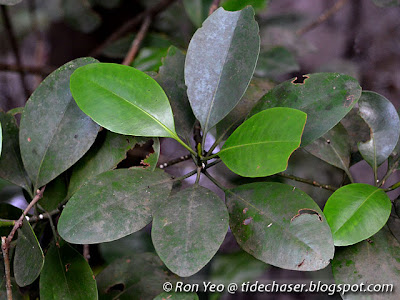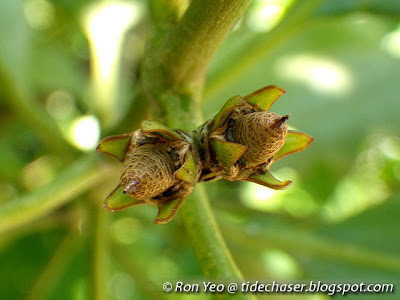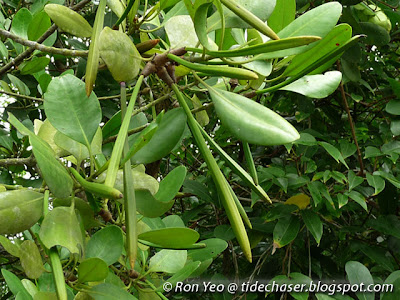Ceriops zippeliana is a nationally endangered species of mangrove tree from the family Rhizophoraceae. It was previously believed to be a synonym of C. decandra, but recent studies shown that they were 2 different species.
Personally, I have seen them occurring more inland in the mangrove forest compared to C. tagal, though there were many occasions which I found both species in the same area. Many were seen on the banks of tidal rivers. Personally, I have seen good populations of this species at various mangrove forests, such as Pulau Semakau, Pulau Ubin, Pasir Ris and Sungei Buloh Wetland Reserve.
The trunk is grey or brown in colour, and mature plants may have small stilt roots at the base of the trunk. The roots radiating from the tree somewhat loop above and below ground, forming knee roots. These roots help the plant breathe air, which is scarce in the waterlogged soil. The roots spread over a wide area to help stabilise the tree on the unstable ground. Like other mangrove species from the family Rhizophoraceae, C. zippeliana relies on its roots to exclude salt from entering the plant through a process called ultrafiltration.
It has simple, opposite leaves with rounded tips. The new leaf buds are laterally compressed, appearing like a blade, and are protected by prominent stipules which fall off as the leaves mature.
The small flowers are white and turn brown quickly, and have 5 thick and claw-like sepals.
C. zippeliana fruits have a textured pattern, unlike C. tagal fruits which are plain.
Vivipary is observed in this plant, as with the other mangrove species from the family Rhizophoraceae. This is a condition whereby the embryo grows and break through the seed coat and the fruit wall while still attached to the parent plant. Hence, the long and green structures seen hanging from the trees are seedlings, and only the brown structures at the top of the green structures are the fruits. The seedlings generally hang in various directions, unlike C. tagal seedlings which usually hang downwards.
C zippeliana seedling has a red collar, unlike, C. tagal, which has a white/yellow collar. The hypocotyl is warty and angular.
The seedling is dispersed by water. It floats horizontally for a few weeks, during which the root (lower part) will absorb water and become heavier, eventually causing the seedling to tip and float vertically. As the tide goes down, the vertically-oriented seedling will sink into the mud or other suitable substrates. Most of the seedlings, however, end up being washed ashore or eaten by animals.
References
- Chong, K. Y., H. T. W. Tan & R. T. Corlett, 2009. A Checklist of the Total Vascular Plant Flora of Singapore: Native, Naturalised and Cultivated Species. Raffles Museum of Biodiversity Research, National University of Singapore. Singapore. 273 pp.
- Giesen, W., S. Wulffraat, M. Zieren & L. Scholten. 2006. Mangrove guidebook for Southeast Asia. RAP Publication 2006/07. FAO Regional Office for Asia and the Pacific & Wetlands International. Bangkok. 769 pp.
- Ng, P. K. L., and N. Sivasothi. 1999. A guide to the mangroves of Singapore 1 : the ecosystem & plant diversity. Singapore Science Centre. Singapore. 168 pp.
- Sheue, C.-R., H.-Y. Liu, C.-C. Tsai, S. M. A. Rashid, J. W. H. Yong, and Y.-P. Yang. 2009. On the morphology and molecular basis of segregation of two species Ceriops zippeliana Blume and C. decandra (Griff.) Ding Hou (Rhizophoraceae) from southeastern Asia. Blumea 54: 220-227.
- Sheue, C.-R., S. M. A. Rashid, J. W. H. Yong, and Y.-P. Yang. 2010. Ceriops zippeliana Blume (Rhizophoraceae), a New Record of a Mangrove Species in Singapore. Taiwania, 55(1): 72-77.

No comments:
Post a Comment